Theme Parks & Themed Entertainment
Why For did Epcot’s Future World not turn out as WED had originally planned?

Epcot Enthusiast wrote in this week to say:
I saw a Tweet today that said that you and Len Testa were
touring Future World and World Showcase recording stories for a new "Unofficial
Guide Disney Dish with Jim Hill" podcast. Epcot is my very favorite WDW theme
park. Could you please share some stories about rides and attractions that were
planned but not built at that theme park?
Dear Epcot Enthusiast,
To be honest, it's kind of hard to know where to begin with
EPCOT Center. There are so many strange & bizarre stories associated with
the development & construction of this futuristic theme park.
Take – for example – how EPCOT Center was initially supposed
to be built much closer to World Drive. With the idea being that you were
literally supposed to be able to see Spaceship Earth looming up over the trees
as you drove past towards The Magic Kingdom.
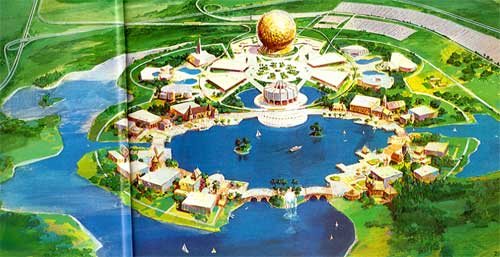
Copyright Disney Enterprises, Inc.
"So why did these plans change?," you ask. During the initial site survey work of this
project, a colony of Red-Cockaded Woodpeckers was found to be nesting right on
the spot where – ironically enough — EPCOT Center's "The Land" pavilion was originally
supposed to be built.
And since continuing with development of this particular piece
of Walt Disney World property would have then disturbed this endangered
species, the Imagineers opted to shift EPCOT Center's construction site over 300
feet to the East. Which was great for the Red-Cockaded Woodpeckers, but kind of
screwed up WED's plans for Spaceship Earth to be dramatically revealed while
driving up World Drive.
"But why didn't Disney just relocated these birds?," you
ask. Well, you have to keep in mind that this was/is a federally-protected
species. So it's not like the Mouse really had any options in this particular
situation. More to the point, The U.S. Fish and Wildlife Service wasn't
entirely sure (at that time, anyway) that Red-Cockaded Woodpeckers could actually
be relocated.
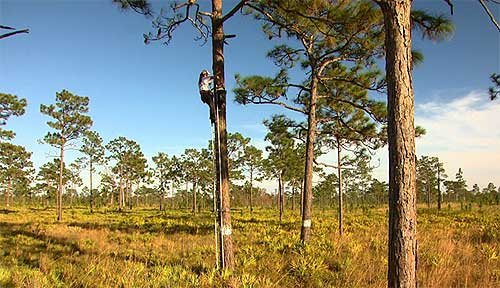
A naturalist at the Disney
Wilderness Preserve places a Red-Cockaded
Woodpecker in its new home
But times changes. And in the Fall of 2008, five pairs of
Red-Cockaded Woodpeckers were successfully moved from Florida's Apalachicola
National Forest to the Disney Wilderness Preserve in Kissimmee. And these birds seem to have really taken to their
new 12,000-acre home. At last count (which was done back in October of 2010),
this Red-Cockaded Woodpecker colony had grown from just 10 birds to 30.
So who knows: If this particular relocation technique had
existed back in the late 1970s (More to the point, if the Feds had be willing
to sign off on the idea of Mickey moving an entire colony of endangered birds),
EPCOT Center would have probably had a slightly different layout. At the very
least, "The Land" pavilion in Future World would have been built in a different
spot.
And speaking of "The Land" … Thanks to "Soarin'," this
Future World pavilion is quite popular with modern-day Epcot visitors. But this
wasn't actually the sort of structure that the Imagineers had originally
planned on building in this part of that theme park.
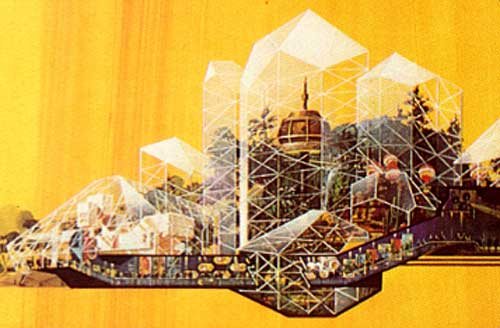
Copyright Disney Enterprises, Inc. All
rights reserved
What WED had originally wanted to fo with "The Land" was
construct this pavilion which was made up of seven massive crystalline
structures. And each of these giant crystal-like chambers was to have housed a
different habitat from the Earth. We're talking snow-covered peaks, the burning
desert, even the lush greenery of the rainforest.
Mind you, only five of these chambers were to have held natural
environments. The other two would have been agricultural and urban
environments. And it was in both of these parts of the show building that the
Imagineers were looking to hammer home the basic premise of this Future World
pavilion:
The Land Pavilion will graphically illustrate man's role as
the "protector" of this finite resource, as well as his alternatives and
choices in maintaining, and even enhancing, the delicate balance within the
natural environment. Through a variety of exciting and informative shows and
experiences, guests will be introduced to the basic concepts essential for
understanding the need for harmony between man and his home on "The Land."

Copyright Disney Enterprises, Inc.
All rights reserved
That's how this Future World pavilion was described in Walt
Disney Productions' 1977 annual report. And as for the rides & the shows
that the Imagineers had in the works for this version of "The Land" back then …
Well, this pavilion's signature attraction was to have been "The Blueprints of
Nature." Where Epcot visitors were to have boarded this balloon and suddenly found
themselves caught up in a fierce snowstorm high up in the mountains.
As these Guests rode along in their balloon, they were to
have followed along as this snow became water and then flowed through the other
six of "The Land" 's natural habitats. As they floated along in their balloon observing
this water from above, these WDW visitors were to be introduced to the four
basic components of Nature's Blueprints (i.e. the snowflakes of Winter, the
germinating seeds of Spring, the flowers of Summer and the leaves of Fall). And
as the water reached the desert habitat and then evaporated, the Guests (aboard
their balloon, of course) were to have followed this water vapor high into the
atmosphere. Where it then was to have reformed as snow.
You get the idea, right? The never-ending cycle of Nature.
How we are all interconnected. More importantly, how fragile our ecosystem
actually is. Which is why man must do everything he can to preserve the balance
of nature. Make sure that this cycle is never interrupted.

Copyright Disney Enterprises, Inc.
All rights reserved
Which was a great message for when "The Land" was supposed
to be sponsored by a lumber company (which wanted Disney to help get across the
message that they were doing everything they could – i.e. replanting forests
after they had harvested all of the trees – to be an environmentally responsible
corporation). But when that would-be Epcot sponsor dropped out and Kraft Foods
then offered to underwrite the construction of this Future World pavilion …
Well, the central story, the underlying message, even the overall look of "The
Land" now had to be radically reworked.
Even so, given all of the architectural work that had
already gone into the creation of this giant crystalline-structure version that
was to have housed this proposed Future World pavilion, the Imagineers didn't
want to totally abandon this design idea. Which is why Epcot's Journey into Imagination
wound up being housed inside of a crystal-shaped show building.
More to the point, given all of the time & effort that
WED had put into designing those seven carefully interconnected natural
habitats that were to have been the heart of the original version of Epcot's "The
Land" pavilion … Well, this wasn't a concept that Dr. Henry Robitaille was
willing to walk away from.
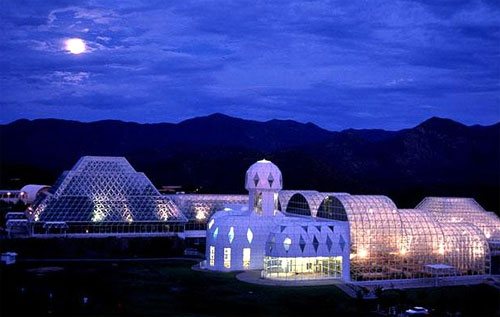
Biosphere 2
For those of you who aren't familiar with Henry's work, Dr.
Robitaille is known worldwide for his contributions to the science of
hydroponics. Dr. Robitaille worked for 20 years on the Epcot project. And if
you're ever floated through "Living with the Land," you've already seen a lot
of Henry's cutting-edge work (EX: soil-less growing technologies) on display in
this Future World pavilion.
Well, Henry genuinely believed that there was something to
WED's original idea for "The Land" (i.e. creating seven interconnected natural
habitats to then demonstrate how the Earth's ecosystem actually worked together).
Which is why – in the late 1980s – Dr. Robitaille agreed to become a consultant
on the Biosphere 2 project.
For those who don't remember this quirky scientific experiment,
Biosphere 2 was this massive glass greenhouse that was built in the Santa
Catalina Mountains north of Tucson, AZ. Built by Space Biosphere Ventures (a
company that received much of its funding from Texas multimillionaire Edward P.
Bass. Whose family – at one time, anyway – used to own almost a quarter of The
Walt Disney Company), this artificially closed-off complete ecosystem was
initially thought to be a dry run for man building a colony on Mars.
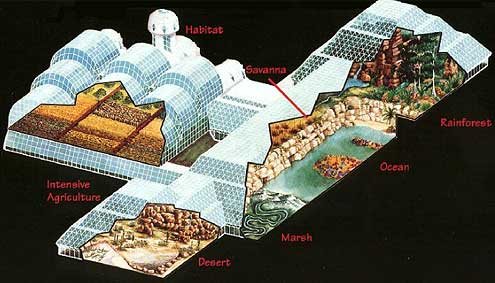
Sadly, personality conflicts and flaws in this enormous enclosed
ecosystem eventually derailed the Biosphere 2 project. Today, this massive
structure is being used by the University of Arizona as an environmental lab.
And speaking of space travel … Perhaps the greatest loss to
the early, early version of Epcot Center was the Space Pavilion. Which – based
on the description of this proposed Future World pavilion which can be found in
Walt Disney Production's 1977 annual report – sounds like it would have been
something truly extraordinary.
Space – a huge, interstellar "Space Vehicle" will transport
passengers to the outer frontiers of the universe, highlighting man's efforts
to reach out for the stars around him … from the early pioneers who looked and
wondered … to modern-day space travelers and their triumphs … to the challenges
and possibilities of future space technologies and exploration.
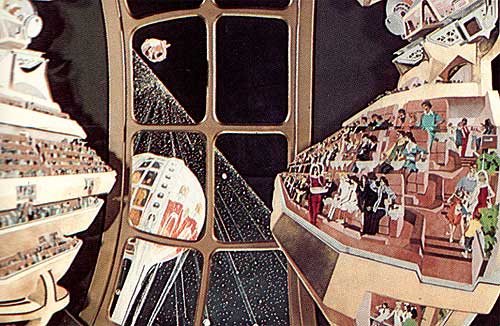
Copyright Disney Enterprises, Inc.
All rights reserved
"And how exactly would this Future World pavilion have
worked?," you ask. The key to pulling off Space's central illusion – that you and
several hundred other Epcot visitors were actually aboard this massive vehicle
that was hurtling through the cosmos – was the Omnimax Sphere. Which was to have
filled this Future World pavilion's many "windows" (i.e. projection screens)
with this moving-in-perfect-sync starfields.
This — coupled with the sleek space vehicle that three-time
Academy Award-winning production designer John De Cuir Sr. had drawn up as well
as the inspired script that sci-fi pioneer Ray Bradbury had written for this proposed
theme park attraction – would have made this version of Future World's "Space"
pavilion a must-see for all Epcot visitors.
"So why wasn't this version of the 'Space' pavilion ever
built?," you ask. For the same reason that many of the rides, shows &
attractions that were initially proposed for Future World & World Showcase never
made it off the drawing board. Because Walt Disney Productions executives had a
lot of trouble lining up sponsors for EPCOT Center. Mainly because many
countries & corporations just couldn't see the long-term benefit of being
associated with this forward-looking theme park.
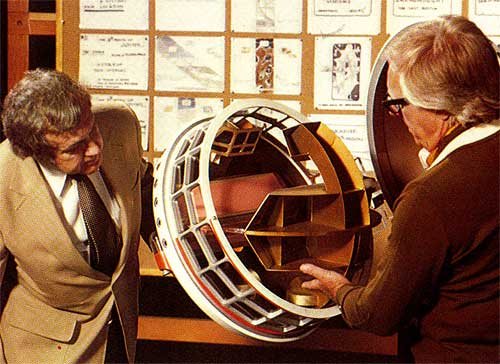
John De Cuir Sr. and Ray Bradbury
examine the model for the show car which was to
have been used in the original
version of Epcot's "Space" pavilion.
Copyright Disney Enterprises, Inc. All
rights reserved
Plus there were mechanical issues with the original version
of Epcot's "Space" pavilion. To be specific, the Imagineers couldn't figure out
an affordable way to make the enormous theater car (which served as the central
ride vehicle for this Future World attraction) feel as though it were actually floating
in space. Which was one of the key emotional beats that Bradbury had included
in his show script. That Epcot visitors – even if it was only for just a moment
– had to experience what it felt like to be in zero gravity.
Mind you, it wasn't 'til some 25 years later — when the
Imagineers came across that centrifuge-based technology which currently powers
Epcot's "Mission: SPACE" attraction — that they actually found a way to give WDW
visitors what Ray had been asking for (i.e. the chance to feel what it's like
to float in space). But WDI did eventually make this happen. Albiet in a very different
form than what De Cuir Sr. and Bradbury had originally proposed.
This has actually happened quite a bit over the course of the
Walt Disney Company's history. The Imagineers come up with a genuinely great
concept from a new ride, show or attractions for the Parks … but then have
absolutely no clue as how they'd pull off a particular effect, build the cost-effective
/ easy-to-operate-and-repair ride system that's necessary to pull off this show concept.
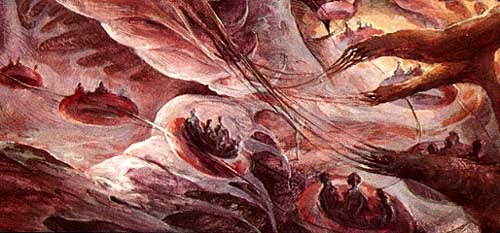
Copyright Disney Enterprises, Inc.
All rights reserved
Take – for example – the "Incredible Journey Within" ride
that was supposed to be the marquee attraction at Epcot's Life & Health
Pavilion. Guests were to have boarded super-sized blood cells and then traveled
through a realistic representation of the human circulatory system,
witnessing " … the inner workings of the fascinating, complex human machine" as
they rode through this Future World show.
The only problem was … The Imagineers had absolutely no clue
how they were going to create a 35 foot-tall working heart value. One that
would flex & pulse continuously for 12 hours a day, seven days a week as
each blood-cell-full-of-WDW-visitors then moved through that particular show
scene in "The Incredible Journey Within."
Which is why it was almost a kindness that it took the Walt
Disney Company so long to find a sponsor for Epcot's "Wonders of Life"
pavilion. By then, the Imagineers had come up with that simulator-based technology
which is used to power "Star Tours." Which made it that much easier to create a
ride film that took Guests on a trip through the human body, rather than
building the enormous & elaborately themed physical sets that would have
been necessary to properly pull off the "Incredible Journey Within" ride.
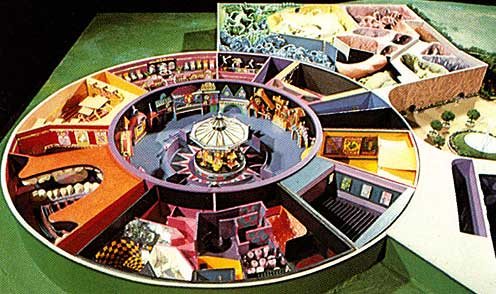
An early model for Epcot's Life and Pavilion.
Please note – that as you look to the back of
this photo – you can see some of
the sets which would have been built for Future
World's "The Incredible Journey
Within" ride. Copyright Disney Enterprises,
Inc. All rights reserved
Now I know that it sometimes depresses Disneyana fans to
read these what-might-have-been articles, hearing about all of these great rides,
shows and attractions that didn't quite make it off of WDI's drawing boards.
Well, at least you're not as disappointed as then-President Jimmy Carter must
have been when he finally got to visit EPCOT Center.
You see, back on October 2, 1978, Card Walker – the then-President
and Chief Executive Officer of Walt Disney Productions – announced that the
Company had decided to definitely move forward with its plans to build EPCOT
Center. And at the 26th World Congress of the International Chamber
of Commerce meeting (which was held that year at Walt Disney World), Walker actually
unveiled Disney's plans for Future World and World Showcase.
So as President Carter and his wife Rosalynn wandered
through that gallery of concept art that the Imagineers had set up in the
convention center at Disney's Contemporary Resort Hotel, they got to see
extremely cool things like the magic carpet ride that was proposed for World
Showcase's United Arab Emirates pavilion. Which was to have sent Guests flying
past scenes straight out of "A Thousand and One Arabian Nights," not to mention
soaring over sequences which were to have showcased what the modern Arab world
was actually like.
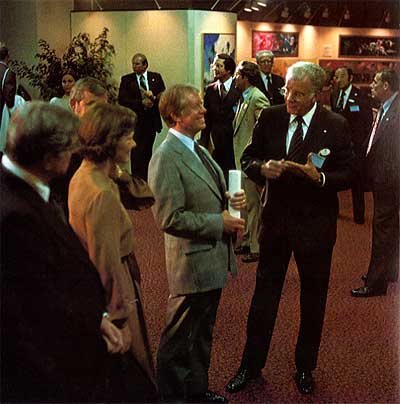
(L to R) as Donn Tatum and
Rosalynn Carter look on, Card Walker
walks President Jimmy Carter through a
gallery full of EPCOT
Center concept art. Copyright Disney Enterprises, Inc.
All rights reserved
And did I mention this magic carpet ride was supposed to
have made use of that mist curtain / project system that Imagineers eventually
installed in "Pirates of the Caribbean" as a way to bring Davy Jones and
Blackbeard into that popular theme park ride? Or that this attraction at Epcot's
United Arab Emirates pavilion was to have featured a Disney-created genie
character that would have predated the one that Robin Williams voiced in "Aladdin"
by more than 10 years?
But the story of the United Arab Emirates' magic carpet ride
will have to wait for a future Why For column. Sorry to be such a tease here.
But this week's story is already 'way too long.
Anyway … That's it for this week. Here's hoping that you
folks have a great Columbus Day Weekend. And in the meantime, remember that –
if you have a Disney-related question that you'd like to see answered in a
future Why For column – you need to send those queries along to whyfor@jimhillmedia.com.
Your thoughts?
History
The Evolution and History of Mickey’s ToonTown

Disneyland in Anaheim, California, holds a special place in the hearts of Disney fans worldwide, I mean heck, it’s where the magic began after all. Over the years it’s become a place that people visit in search of memorable experiences. One fan favorite area of the park is Mickey’s Toontown, a unique land that lets guests step right into the colorful, “Toony” world of Disney animation. With the recent reimagining of the land and the introduction of Micky and Minnies Runaway Railway, have you ever wondered how this land came to be?
There is a fascinating backstory of how Mickey’s Toontown came into existence. It’s a tale of strategic vision, the influence of Disney executives, and a commitment to meeting the needs of Disney’s valued guests.
The Beginning: Mickey’s Birthdayland
The story of Mickey’s Toontown starts with Mickey’s Birthdayland at Walt Disney World’s Magic Kingdom. Opened in 1988 to celebrate Mickey Mouse’s 60th birthday, this temporary attraction was met with such overwhelming popularity that it inspired Disney executives to think bigger. The idea was to create a permanent, immersive land where guests could step into the animated world of Mickey Mouse and his friends.
In the early ’90s, Disneyland was in need of a refresh. Michael Eisner, the visionary leader of The Walt Disney Company at the time, had an audacious idea: create a brand-new land in Disneyland that would celebrate Disney characters in a whole new way. This was the birth of Mickey’s Toontown.
Initially, Disney’s creative minds toyed with various concepts, including the idea of crafting a 100-Acre Woods or a land inspired by the Muppets. However, the turning point came when they considered the success of “Who Framed Roger Rabbit.” This film’s popularity and the desire to capitalize on contemporary trends set the stage for Toontown’s creation.
From Concept to Reality: The Birth of Toontown
In 1993, Mickey’s Toontown opened its gates at Disneyland, marking the first time in Disney Park history where guests could experience a fully realized, three-dimensional world of animation. This new land was not just a collection of attractions but a living, breathing community where Disney characters “lived,” worked, and played.
Building Challenges: Innovative Solutions
The design of Mickey’s Toontown broke new ground in theme park aesthetics. Imagineers were tasked with bringing the two-dimensional world of cartoons into a three-dimensional space. This led to the creation of over 2000 custom-built props and structures that embodied the ‘squash and stretch’ principle of animation, giving Toontown its distinctiveness.
And then there was also the challenge of hiding the Team Disney Anaheim building, which bore a striking resemblance to a giant hotdog. The Imagineers had to think creatively, using balloon tests and imaginative landscaping to seamlessly integrate Toontown into the larger park.

Key Attractions: Bringing Animation to Life
Mickey’s Toontown featured several groundbreaking attractions. “Roger Rabbit’s Car Toon Spin,” inspired by the movie “Who Framed Roger Rabbit,” became a staple of Toontown, offering an innovative ride experience. Gadget’s Go-Coaster, though initially conceived as a Rescue Rangers-themed ride, became a hit with younger visitors, proving that innovative design could create memorable experiences for all ages.
Another crown jewel of Toontown is Mickey’s House, a walkthrough attraction that allowed guests to explore the home of Mickey Mouse himself. This attraction was more than just a house; it was a carefully crafted piece of Disney lore. The house was designed in the American Craftsman style, reflecting the era when Mickey would have theoretically purchased his first home in Hollywood. The attention to detail was meticulous, with over 2000 hand-crafted, custom-built props, ensuring that every corner of the house was brimming with character and charm. Interestingly, the design of Mickey’s House was inspired by a real home in Wichita Falls, making it a unique blend of real-world inspiration and Disney magic.
Mickey’s House also showcased Disney’s commitment to creating interactive and engaging experiences. Guests could make themselves at home, sitting in Mickey’s chair, listening to the radio, and exploring the many mementos and references to Mickey’s animated adventures throughout the years. This approach to attraction design – where storytelling and interactivity merged seamlessly – was a defining characteristic of ToonTown’s success.

Executive Decisions: Shaping ToonTown’s Unique Attractions
The development of Mickey’s Toontown wasn’t just about creative imagination; it was significantly influenced by strategic decisions from Disney executives. One notable input came from Jeffrey Katzenberg, who suggested incorporating a Rescue Rangers-themed ride. This idea was a reflection of the broader Disney strategy to integrate popular contemporary characters and themes into the park, ensuring that the attractions remained relevant and engaging for visitors.
In addition to Katzenberg’s influence, Frank Wells, the then-President of The Walt Disney Company, played a key role in the strategic launch of Toontown’s attractions. His decision to delay the opening of “Roger Rabbit’s Car Toon Spin” until a year after Toontown’s debut was a calculated move. It was designed to maintain public interest in the park by offering new experiences over time, thereby giving guests more reasons to return to Disneyland.
These executive decisions highlight the careful planning and foresight that went into making Toontown a dynamic and continuously appealing part of Disneyland. By integrating current trends and strategically planning the rollout of attractions, Disney executives ensured that Toontown would not only capture the hearts of visitors upon its opening but would continue to draw them back for new experiences in the years to follow.
Global Influence: Toontown’s Worldwide Appeal
The concept of Mickey’s Toontown resonated so strongly that it was replicated at Tokyo Disneyland and influenced elements in Disneyland Paris and Hong Kong Disneyland. Each park’s version of Toontown maintained the core essence of the original while adapting to its cultural and logistical environment.
Evolution and Reimagining: Toontown Today
As we approach the present day, Mickey’s Toontown has recently undergone a significant reimagining to welcome “Mickey & Minnie’s Runaway Railway” in 2023. This refurbishment aimed to enhance the land’s interactivity and appeal to a new generation of Disney fans, all while retaining the charm that has made ToonTown a beloved destination for nearly three decades.

Dive Deeper into ToonTown’s Story
Want to know more about Mickey’s Toontown and hear some fascinating behind-the-scenes stories, then check out the latest episode of Disney Unpacked on Patreon @JimHillMedia. In this episode, the main Imagineer who worked on the Toontown project shares lots of interesting stories and details that you can’t find anywhere else. It’s full of great information and fun facts, so be sure to give it a listen!
History
Unpacking the History of the Pixar Place Hotel

Pixar Place Hotel, the newly unveiled 15-story tower at the Disneyland Resort, has been making waves in the Disney community. With its unique Pixar-themed design, it promises to be a favorite among visitors.
However, before we delve into this exciting addition to the Disneyland Resort, let’s take a look at the fascinating history of this remarkable hotel.
The Emergence of the Disneyland Hotel
To truly appreciate the story of the Pixar Place Hotel, we must turn back the clock to the early days of Disneyland. While Walt Disney had the visionary ideas and funding to create the iconic theme park, he faced a challenge when it came to providing accommodations for the park’s visitors. This is where his friend Jack Wrather enters the picture.
Jack Wrather, a fellow pioneer in the television industry, stepped in to assist Walt Disney in realizing his dream. Thanks to the success of the “Lassie” TV show produced by Wrather’s company, he had the financial means to build a hotel right across from Disneyland.
The result was the Disneyland Hotel, which opened its doors in October 1955. Interestingly, the early incarnation of this hotel had more of a motel feel than a hotel, with two-story buildings reminiscent of the roadside motels popular during the 1950s. The initial Disneyland Hotel consisted of modest structures that catered to visitors looking for affordable lodging close to the park. While the rooms were basic, it marked the beginning of something extraordinary.
The Evolution: From Emerald of Anaheim to Paradise Pier
As Disneyland’s popularity continued to soar, so did the demand for expansion and improved accommodations. In 1962, the addition of an 11-story tower transformed the Disneyland Hotel, marking a significant transition from a motel to a full-fledged hotel.
The addition of the 11-story tower elevated the Disneyland Hotel into a more prominent presence on the Anaheim skyline. At the time, it was the tallest structure in all of Orange County. The hotel’s prime location across from Disneyland made it an ideal choice for visitors. With the introduction of the monorail linking the park and the hotel, accessibility became even more convenient. Unique features like the Japanese-themed reflecting pools added to the hotel’s charm, reflecting a cultural influence that extended beyond Disney’s borders.
Japanese Tourism and Its Impact
During the 1960s and 1970s, Disneyland was attracting visitors from all corners of the world, including Japan. A significant number of Japanese tourists flocked to Anaheim to experience Walt Disney’s creation. To cater to this growing market, it wasn’t just the Disneyland Hotel that aimed to capture the attention of Japanese tourists. The Japanese Village in Buena Park, inspired by a similar attraction in Nara, Japan, was another significant spot.
These attractions sought to provide a taste of Japanese culture and hospitality, showcasing elements like tea ceremonies and beautiful ponds with rare carp and black swans. However, the Japanese Village closed its doors in 1975, likely due to the highly competitive nature of the Southern California tourist market.
The Emergence of the Emerald of Anaheim
With the surge in Japanese tourism, an opportunity arose—the construction of the Emerald of Anaheim, later known as the Disneyland Pacific Hotel. In May 1984, this 15-story hotel opened its doors.
What made the Emerald unique was its ownership. It was built not by The Walt Disney Company or the Oriental Land Company (which operated Tokyo Disneyland) but by the Tokyu Group. This group of Japanese businessmen already had a pair of hotels in Hawaii and saw potential in Anaheim’s proximity to Disneyland. Thus, they decided to embark on this new venture, specifically designed to cater to Japanese tourists looking to experience Southern California.
Financial Challenges and a Changing Landscape
The late 1980s brought about two significant financial crises in Japan—the crash of the NIKKEI stock market and the collapse of the Japanese real estate market. These crises had far-reaching effects, causing Japanese tourists to postpone or cancel their trips to the United States. As a result, reservations at the Emerald of Anaheim dwindled.
To adapt to these challenging times, the Tokyu Group merged the Emerald brand with its Pacific hotel chain, attempting to weather the storm. However, the financial turmoil took its toll on the Emerald, and changes were imminent.
The Transition to the Disneyland Pacific Hotel
In 1995, The Walt Disney Company took a significant step by purchasing the hotel formerly known as the Emerald of Anaheim for $35 million. This acquisition marked a change in the hotel’s fortunes. With Disney now in control, the hotel underwent a name change, becoming the Disneyland Pacific Hotel.
Transformation to Paradise Pier
The next phase of transformation occurred when Disney decided to rebrand the hotel as Paradise Pier Hotel. This decision aligned with Disney’s broader vision for the Disneyland Resort.
While the structural changes were limited, the hotel underwent a significant cosmetic makeover. Its exterior was painted to complement the color scheme of Paradise Pier, and wave-shaped crenellations adorned the rooftop, creating an illusion of seaside charm. This transformation was Disney’s attempt to seamlessly integrate the hotel into the Paradise Pier theme of Disney’s California Adventure Park.
Looking Beyond Paradise Pier: The Shift to Pixar Place
In 2018, Disneyland Resort rebranded Paradise Pier as Pixar Pier, a thematic area dedicated to celebrating the beloved characters and stories from Pixar Animation Studios. As a part of this transition, it became evident that the hotel formally known as the Disneyland Pacific Hotel could no longer maintain its Paradise Pier theme.
With Pixar Pier in full swing and two successful Pixar-themed hotels (Toy Story Hotels in Shanghai Disneyland and Tokyo Disneyland), Disney decided to embark on a new venture—a hotel that would celebrate the vast world of Pixar. The result is Pixar Place Hotel, a 15-story tower that embraces the characters and stories from multiple Pixar movies and shorts. This fully Pixar-themed hotel is a first of its kind in the United States.
The Future of Pixar Place and Disneyland Resort
As we look ahead to the future, the Disneyland Resort continues to evolve. The recent news of a proposed $1.9 billion expansion as part of the Disneyland Forward project indicates that the area surrounding Pixar Place is expected to see further changes. Disneyland’s rich history and innovative spirit continue to shape its destiny.
In conclusion, the history of the Pixar Place Hotel is a testament to the ever-changing landscape of Disneyland Resort. From its humble beginnings as the Disneyland Hotel to its transformation into the fully Pixar-themed Pixar Place Hotel, this establishment has undergone several iterations. As Disneyland Resort continues to grow and adapt, we can only imagine what exciting developments lie ahead for this iconic destination.
If you want to hear more stories about the History of the Pixar Place hotel, check our special edition of Disney Unpacked over on YouTube.
Stay tuned for more updates and developments as we continue to explore the fascinating world of Disney, one story at a time.
History
From Birthday Wishes to Toontown Dreams: How Toontown Came to Be

In the latest release of Episode 4 of Disney Unpacked, Len and I return, joined as always by Disney Imagineering legend, Jim Shull. This two-part episode covers all things Mickey’s Birthday Land and how it ultimately led to the inspiration behind Disneyland’s fan-favorite land, “Toontown”. But let’s not get ahead of ourselves here. It all starts in the early days at Disneyland.
Early Challenges in Meeting Mickey
Picture this: it’s the late 1970s and early 1980s, and you’re at Disneyland. You want to meet the one and only Mickey Mouse, but there’s no clear way to make it happen. You rely on Character Guides, those daily printed sheets that point you in Mickey’s general direction. But let’s be honest, it was like finding a needle in a haystack. Sometimes, you got lucky; other times, not so much.

Mickey’s Birthdayland: A Birthday Wish that Came True
Fast forward to the late 1980s. Disney World faced a big challenge. The Disney-MGM Studios Theme Park was under construction, with the company’s marketing machine in full swing, hyping up the opening of Walt Disney World’s third theme park, MGM Studios, in the Spring of 1989. This extensive marketing meant that many people were opting to postpone their family’s next trip to Walt Disney World until the following year. Walt Disney World needed something compelling to motivate guests to visit Florida in 1988, the year before Disney MGM Studios opened.
Enter stage left, Mickey’s Birthdayland. For the first time ever, an entire land was dedicated to a single character – and not just any character, but the mouse who started it all. Meeting Mickey was no longer a game of chance; it was practically guaranteed.

The Birth of Birthdayland: Creative Brilliance Meets Practicality
In this episode, we dissect the birth of Mickey’s Birthdayland, an initiative that went beyond celebrating a birthday. It was a calculated move, driven by guest feedback and a need to address issues dating back to 1971. Imagineers faced the monumental task of designing an experience that honored Mickey while efficiently managing the crowds. This required the perfect blend of creative flair and logistical prowess – a hallmark of Disney’s approach to theme park design.
Evolution: From Birthdayland to Toontown
The success of Mickey’s Birthdayland was a real game-changer, setting the stage for the birth of Toontown – an entire land that elevated character-centric areas to monumental new heights. Toontown wasn’t merely a spot to meet characters; it was an immersive experience that brought Disney animation to life. In the episode, we explore its innovative designs, playful architecture, and how every nook and cranny tells a story.

Impact on Disney Parks and Guests
Mickey’s Birthdayland and Toontown didn’t just reshape the physical landscape of Disney parks; they transformed the very essence of the guest experience. These lands introduced groundbreaking ways for visitors to connect with their beloved characters, making their Disney vacations even more unforgettable.
Beyond Attractions: A Cultural Influence
But the influence of these lands goes beyond mere attractions. Our episode delves into how Mickey’s Birthdayland and Toontown left an indelible mark on Disney’s culture, reflecting the company’s relentless dedication to innovation and guest satisfaction. It’s a journey into how a single idea can grow into a cherished cornerstone of the Disney Park experience.

Unwrapping the Full Story of Mickey’s Birthdayland
Our two-part episode of Disney Unpacked is available for your viewing pleasure on our Patreon page. And for those seeking a quicker Disney fix, we’ve got a condensed version waiting for you on our YouTube channel. Thank you for being a part of our Disney Unpacked community. Stay tuned for more episodes as we continue to “Unpack” the fascinating world of Disney, one story at a time.
-
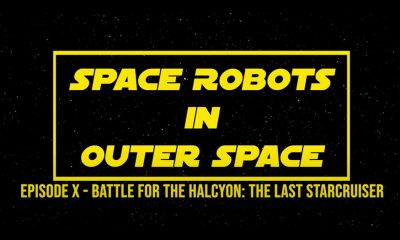
 News & Press Releases12 months ago
News & Press Releases12 months agoStar Wars Spoof: Space Robots in Outer Space Ep X: Battle for the Halcyon: The Last Starcruiser
-

 History11 months ago
History11 months ago31 Long-Gone Rides, Shows & Attractions at Disney-MGM (Hollywood Studios)
-

 News & Press Releases8 months ago
News & Press Releases8 months agoDisney Will Bring D23: The Ultimate Disney Fan Event to Anaheim, California in August 2024
-

 History3 months ago
History3 months agoFrom Birthday Wishes to Toontown Dreams: How Toontown Came to Be
-

 Theme Parks & Themed Entertainment11 months ago
Theme Parks & Themed Entertainment11 months agoFrom Aladdin to Indy – How Did We Get an Indiana Jones Stage Show at Disneyland?
-

 Theme Parks & Themed Entertainment12 months ago
Theme Parks & Themed Entertainment12 months agoHow Did We Get “Aladdin’s Oasis” at Disneyland?
-

 Theme Parks & Themed Entertainment10 months ago
Theme Parks & Themed Entertainment10 months agoWhen WDW Had a Racetrack – The Creation of the Walt Disney World Speedway
-

 Film & Movies10 months ago
Film & Movies10 months ago“Indiana Jones and the Search for Indiana Jones”








